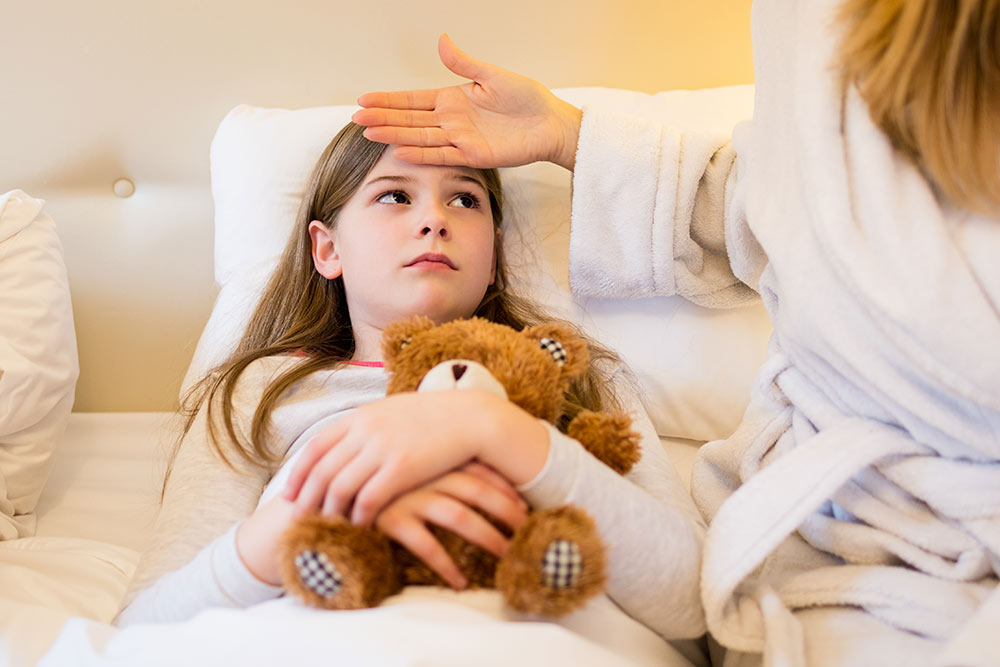
We know that when your child has a fever, it can be scary for parents. However, fever itself is not harmful. Fever can actually be a good thing – it means your child’s body is fighting the infection!
What is a fever?
A normal body temperature is 98.6 degrees fahrenheit plus or minus 1 degree. A fever is a rectal temperature over 100.4.
Check out this link for more information on how to take your child’s temperature
What causes a fever?
When our bodies detect an infection, our brain responds by raising the temperature to try to fight the infection.
How should I treat a fever?
Fevers can be treated with fever reducers such as acetaminophen (Tylenol) or ibuprofen (Advil, Motrin).
- Acetaminophen can be given every 4 hours
- Ibuprofen can be given every 6 hours
- You can alternate the medications every 4 hours. For example, acetaminophen at 8am, ibuprofen at 11am, acetaminophen at 2pm, ibuprofen at 5pm, etc.
- Children <16 years old should NOT be treated with aspirin due to the risk of Reye’s syndrome
Tylenol® Chart
See the chart below for correct dosing for acetaminophen. The dose is based on weight, which may not correspond with age.
Dose every 4 hours as needed. Do not give more than 5 doses in 24 hours.
| Weights | Age | Infants’ Tylenol® Oral Suspension | Children’s Tylenol® Oral Suspension |
|---|---|---|---|
| 6-11 lbs | 0-3 mos | 1.25 mL | – |
| 12-17 lbs | 4-11 mos | 2.5 mL | – |
| 18-23 lbs | 12-23 mos | 3.75 mL | – |
| 24-35 lbs | 2-3 yrs | 5 mL | 5 mL (1 tsp) |
| 36-47 lbs | 4-5 yrs | – | 7.5 mL (1½ tsp) |
| 48-59 lbs | 6-8 yrs | – | 10 mL (2 tsp) |
| 60-71 lbs | 9-10 yrs | – | 12.5 mL (2½ tsp) |
| 72-95 lbs | 11 yrs | – | 15 mL (3 tsp) |
- Do NOT use with any other products containing acetaminophen
- Use only the dosing device that comes with a specific product
Motrin® Chart
See the chart below for correct dosing for ibuprofen. The dose is based on weight, which may not correspond with age.
Dose every 6-8 hours as needed. Do not give more than 4 doses in 24 hours.
| Weights | Age | Concentrated Motrin® Infants’ Drops | Children’s Motrin® Oral Suspension |
|---|---|---|---|
| 6-11 lbs | 0-5 mos | – | – |
| 12-17 lbs | 6-11 mos | 1.25 mL | – |
| 18-23 lbs | 12-23 mos | 1.875 mL | – |
| 24-35 lbs | 2-3 yrs | – | 5 mL (1 tsp) |
| 36-47 lbs | 4-5 yrs | – | 7.5 mL (1½ tsp) |
| 48-59 lbs | 6-8 yrs | – | 10 mL (2 tsp) |
| 60-71 lbs | 9-10 yrs | – | 12.5 mL (2½ tsp) |
| 72-95 lbs | 11 yrs | – | 15 mL (3 tsp) |
- Do NOT administer longer than 10 days, unless directed by a doctor
- Ask a doctor or pharmacist before use if the child is taking any other drug containing an NSAID (nonsteroidal anti-inflammatory drug), prescription or non-prescription
- Use only the dosing device that comes with a specific product
How high is too high?
This is one of the most common questions we get. It is rare for fever itself to cause injury, and even then it only happens around 107 degrees. However, we know high fevers can be worrisome. If your child’s temperature is over 105 degrees, then call your pediatrician for further advice.
*Overall, it is more important to go by how your child looks rather than how high the fever is. If your child has a temperature of 103 but is drinking and acting ok, that is less concerning than a child with a temperature of 101 who looks very ill and can’t hardly wake up.
I gave medicine but I can’t get the fever under 101
The first thing to do is to check your child’s weight and make sure you have given the correct dose. See the charts above for dosing.
Also, remember that your child’s body is trying to fight the infection. Often, it is trying to heat things up to 103-104 degrees and you are trying to give medication to get it to 98-99 degrees. Often you will meet in the middle and stay around 101-102. That is ok! Go by how your child looks rather than just looking at a number!
When should I be concerned?
Call the doctor right away or go to the nearest ER if your child has fever and:
- Is younger than 3 months old
- Looks very ill or is very lethargic
- Has a stiff neck, severe headache, or unexplained rash
- Has signs of dehydration (decreased urine output, weight loss, dry lips, not making tears)
- Has a seizure
- Has a temperature over 106 degrees




